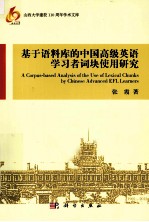

基于语料库的中国高级英语学习者词块使用研究PDF电子书下载
- 电子书积分:9 积分如何计算积分?
- 作 者:张霞编
- 出 版 社:北京:科学出版社
- 出版年份:2012
- ISBN:9787030339782
- 页数:199 页
Introduction 1
Chapter 1 Lexical Chunks and Language Description 6
1.1 The conventional use of language as a long-standing and long-recognized phenomenon 6
1.1.1 A de facto,long-standing and wide-spread phenomenon 6
1.1.2 A long recognized phenomenon 9
1.2 The centralization of conventional language in neo-Firthian researches 12
1.2.1 The difference between the functionalist and mentalist paradigms 12
1.2.2 From meaning and function to the conventional use of language 14
1.2.3 How neo-Firthian arguments solve the problem of productivity 19
1.3 Lexical chunks as representing conventionality in language use 21
1.3.1 The nature of lexical churks 21
1.3.2 Features of lexical chunks 22
1.4 A review of the methodology development in studies of lexical chunks 30
1.4.1 The marginalization of phraseology and the salience approach 31
1.4.2 The centralization of phraseology and the statistical approach 32
1.4.3 Altenberg,Biber and the study of lexical chunks 35
1.5 Summary 37
Chapter 2 Lexical Chunks and Language Acquisition 39
2.1 A comparison 39
2.2 Holistic language processing and FLA 40
2.2.1 Explanatory adequacy and the alternative expediency 41
2.2.2 Holistic language processing and the route of FLA 42
2.2.3 The role of holistic language processing in FLA 44
2.3 Lexical chunks and SLA 45
2.3.1 Differences and similarities between advanced EFL learners and first language acquiring children 46
2.3.2 Lexical chunks and the route of SLA 47
2.3.3 Lexical chunks and the success of SLA-the social-functional level 48
2.3.4 Lexical chunks and the success of SLA-the lexico-grammatical level 50
2.3.5 Lexical chunks and the success of SLA-extant studies 51
2.4 Procedural vocabulary and lexical chunks 53
2.4.1 The conception of procedural vocabulary 53
2.4.2 The relationship between procedural vocabulary and lexical chunk 55
2.5 Deviations in learners'use of lexical chunks-description and diagnosis 57
2.5.1 Two kinds of deviations and two approaches to the diagnosis 58
2.5.2 The CIA approach and the diagnosis of learner deviations 59
2.5.3 The research questions of the present research 61
2.6 The acquisition of lexical chunks in the classroom context 63
2.7 Summary 66
Chapter 3 The Methodology 68
3.1 An NLP perspective of the study of lexical chunks 68
3.1.1 Hybrid algorithms 69
3.1.2 Association measures 71
3.1.3 Statistical algorithms to decide MWU boundary 73
3.1.4 Dispersion 75
3.1.5 The extraction of procedural vocabulary 76
3.1.6 The automatic extraction of patterns around a certain word 78
3.2 The methodology of the present study 79
3.2.1 Corpora used-size,sampling and preprocessing 79
3.2.2 The extraction of lexical chunks:length range,frequency,dispersion and boundary determination 81
3.2.3 The filtering process 84
3.2.4 Tools of lexical chunk extraction 85
3.2.5 Annotation 86
3.2.6 The extraction of PV 88
3.2.7 Word-form based lexical chunks and POS-tag sequences around PV 90
3.3 The research design of the present study 93
Chapter 4 Word-form Based Lexical Chunks 95
4.1 The proportion issue 95
4.2 Types and tokens of lexical chunks in different length categories 96
4.3 Types,tokens and type/token ratio of lexical chunks in different corpora 98
4.4 The structure and function characteristics of lexical chunks 101
4.4.1 Dependent clause 107
4.4.2 Independent clause 110
4.4.3 Single clause constituent 111
4.4.4 Incomplete phrase 112
4.4.5 Multiple clause constituents 113
4.4.6 The interaction between function and corpus 123
4.5 Discussion and summary 126
Appendix:Complementary statistical analyses 127
Chapter 5 POS-tag Sequences Around PV 131
5.1 Procedural words in the four corpora 131
5.1.1 Rank correlation analysis 131
5.1.2 Distribution of content and function words 135
5.1.3 Distribution of PV of various parts of speech 137
5.2 The relationship between procedural words and lexical chunks 140
5.2.1 The proof of the close relationship between PV and lexical chunks 140
5.2.2 Descriptive statistics 144
5.3 procedural words common to the corpora under study 146
5.3.1 Analysis of take 147
5.3.2 Analysis of make 156
5.3.3 Analysis of time and way 163
5.4 Summary 168
Appendix:Complementary statistical analysis 169
Chapter 6 Major Findings Revisited 173
6.1 Major findings and conclusions 173
6.2 Limitations and prospects 175
6.2.1 Higher degree of abstractness 175
6.2.2 Semantic prosody and discoursal functions 176
6.2.3 The developmental dimension 177
6.2.4 Procedural vocabulary 178
References 180
Appendix 191
- 《党员干部理论学习培训教材 理论热点问题党员干部学习辅导》(中国)胡磊 2018
- 《“十三五”规划教材 中药鉴定学实验 供中药学 药学及相关专业使用 第2版》吴啟南 2018
- 《深度学习与飞桨PaddlePaddle Fluid实战》于祥 2019
- 《全国普通高等中医药院校药学类专业“十三五”规划教材 第二轮规划教材 有机化学学习指导 第2版》赵骏 2018
- 《基于核心素养的有效学习与学业评价策略 初中政治》李亚莉主编 2018
- 《新编临床药物使用规范》孙国栋,解华主编 2017
- 《人体寄生虫学学习指导与习题集 供基础 临床 预防 口腔医学类专业用 第2版》诸欣平,苏川 2018
- 《大学信息技术基础学习与实验指导教程》安世虎主编 2019
- 《牛津中国心理学手册 上 认知与学习》(美)迈克尔·哈里斯·邦德主编;赵俊华,张春妹译 2019
- 《中国农药研究与应用全书 农药科学合理使用》欧晓明,司乃国,陈杰编 2019
- 《东方杂志 第110册 第25卷 第一至四号 1928年1月-1928年2月》上海书店出版社编 2012
- 《清明 我们的节日》冯骥才编 2017
- 《现代水泥技术发展与应用论文集》天津水泥工业设计研究院有限公司编 2019
- 《甘肃省档案馆指南》甘肃省档案馆编 2018
- 《莼江曲谱 2 中国昆曲博物馆藏稀见昆剧手抄曲谱汇编之一》郭腊梅主编;孙伊婷副主编;孙文明,孙伊婷编委;中国昆曲博物馆编 2018
- 《花时间 我的第一堂花艺课 插花基础技法篇》(日)花时间编辑部编;陈洁责编;冯莹莹译 2020
- 《中央财政支持提升专业服务产业发展能力项目水利工程专业课程建设成果 设施农业工程技术》赵英编 2018
- 《东方杂志 第94册 第22卷 第四至七号 1925年2月-1925年4月》上海书店出版社编 2012
- 《远去的老调》经典文库编委会编 2019
- 《东方杂志 第13册 第四年 第一至三期 1907年3月-1907年5月》上海书店出版社编 2012
- 《指向核心素养 北京十一学校名师教学设计 英语 七年级 上 配人教版》周志英总主编 2019
- 《《走近科学》精选丛书 中国UFO悬案调查》郭之文 2019
- 《北京生态环境保护》《北京环境保护丛书》编委会编著 2018
- 《中医骨伤科学》赵文海,张俐,温建民著 2017
- 《美国小学分级阅读 二级D 地球科学&物质科学》本书编委会 2016
- 《指向核心素养 北京十一学校名师教学设计 英语 九年级 上 配人教版》周志英总主编 2019
- 《强磁场下的基础科学问题》中国科学院编 2020
- 《小牛顿科学故事馆 进化论的故事》小牛顿科学教育公司编辑团队 2018
- 《小牛顿科学故事馆 医学的故事》小牛顿科学教育公司编辑团队 2018
- 《高等院校旅游专业系列教材 旅游企业岗位培训系列教材 新编北京导游英语》杨昆,鄢莉,谭明华 2019
